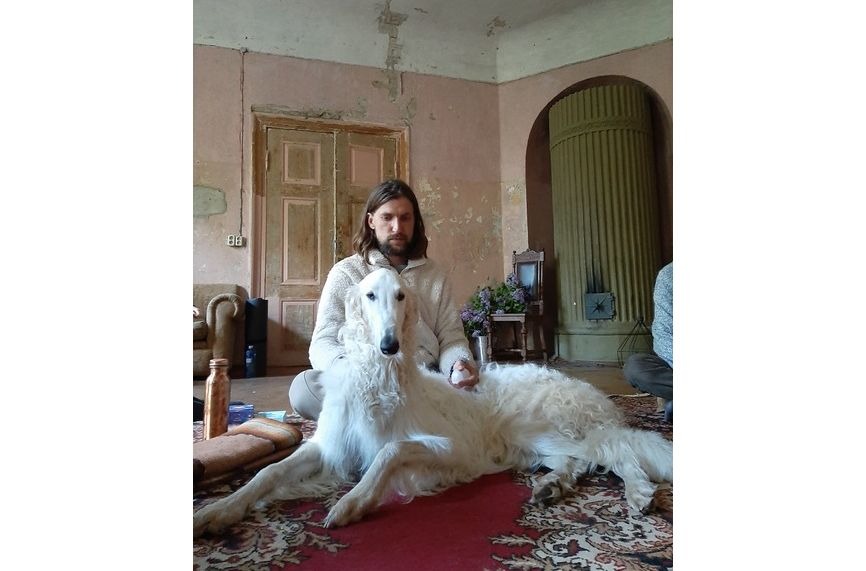
The soul’s map to the labyrinth of the subconscious
Una Meistere, Ainārs Ērglis
A conversation with artist Atis Jakobsons
This conversation with Atis Jakobsons took place in the Latvian coastal village of Mazirbe, where he has just exhibited six works from his most recent series, Vision. The show is part of the first exhibition of EnergArt, Arterritory’s nomadic gallery.
They begin as pastel drawings. Jakobsons explains how after a long period of monochrome, he has recently been increasingly returning to colour. “Colour for me is no longer just colour – it is sound, a frequency. And it is scientifically measurable. (...) I think that intuitively, either consciously or unconsciously, I’m approaching art therapy. Healing through colour. Being in a field of colour really does heal you; colour is a pure frequency. Pure energy.” An intangible calm enters the room along with Jakobsons’ works; quietly, unobtrusively and touchingly, they lead us deeper... Into a world where there are no more words, only sensations and their projections into oneself.
During these same days, Jakobsons’ solo exhibition opens at Padure Manor. It features paintings made in the last three years. Portraits and still lifes. Although Jakobsons did not paint them while on the estate, there is a sense that they are, nevertheless, about the estate. As if they had been waiting for the moment when they finally would get there. Having crossed the threshold of the manor, the viewer enters a synergistic space of being and existence that serves as a kind of bridge – allowing one to climb very high, but also to go very deep. There are infinite depths of density on both sides. Somewhere in the middle there is a fragile equilibrium, much like the incorporeal water that sits in the vessels in Jakobsons’ paintings. It vibrates, purifies and transforms. And there is no rational explanation for how this happens. Just like there is no explanation for what happens. It is this, the intangible, that we discuss. And it is definitely felt by Rafaels and Mazais, Jakobsons’ two dogs who gracefully move about in the background – imperceptibly and, at the same time, unmistakably. Or more precisely, they are present.
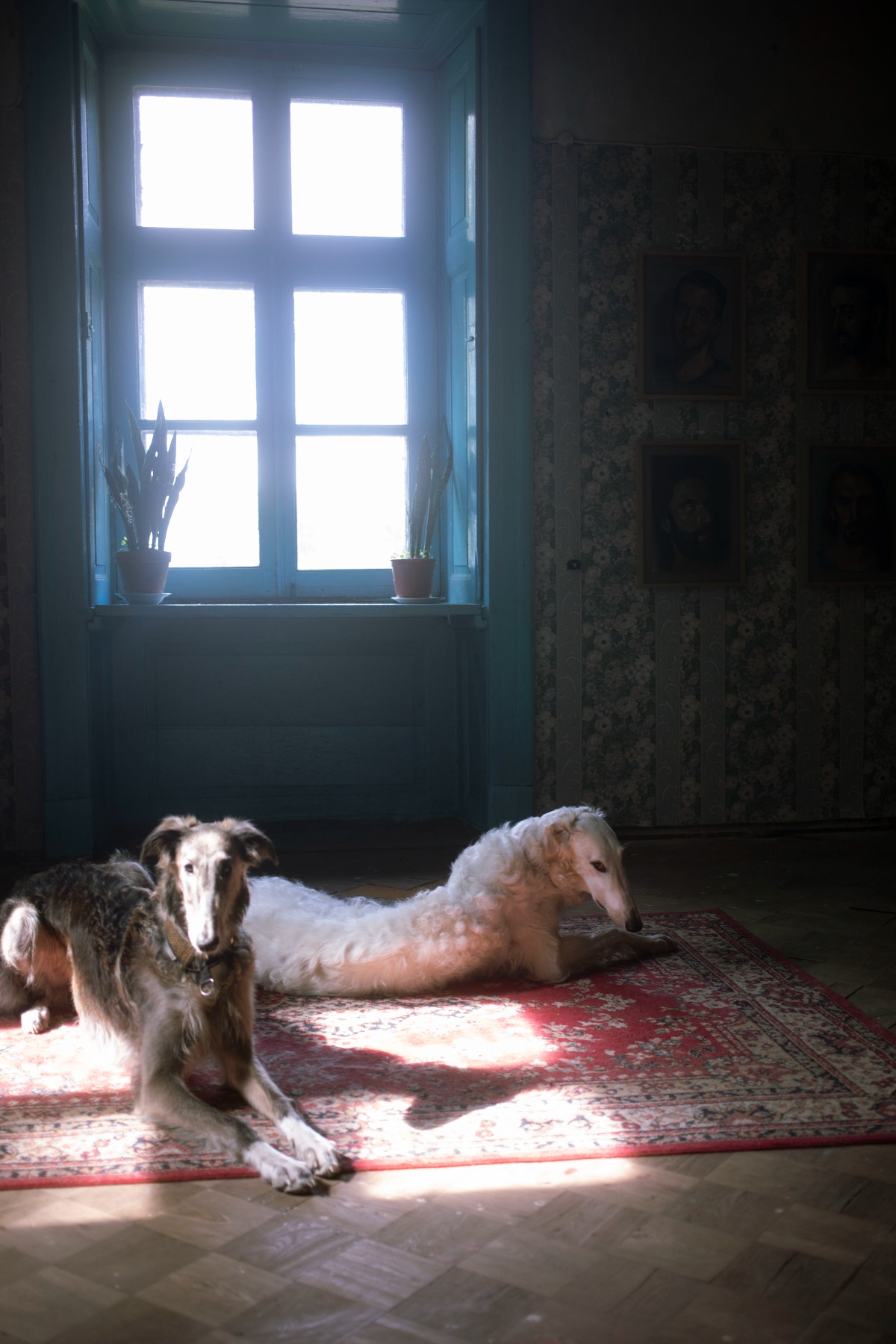
You work a lot with the theme of energy, something that is not easily tangible. Have you always believed that you are conveying the intangible? Where are you now in your journey as an artist – at a kind of crossroads?
Probably at the beginning. That turn started quite clichéd – with a trip to India. It was 2012, I had graduated from the Art Academy of Latvia, and then there was really a kind of crossroads. An economic crisis. I felt that something had to change. I was in India for three months; I had all kinds of experiences and it opened up a whole new dimension. I came back happy and looking at the world in a much different way.
I think the energy thing has been in me for a long time. A lot of things take place in my dreams. I dream a lot, but I also realise that they are not just dreams – it is also an entering into other realities. There are night experiences when you realise that there is something more there. I have crossed into other realities and I have had some very important visitors.
Looking back, there have been many significant dreams. For example, I remember sitting in the street, people are running at each other with baseball bats, various sharp objects, glass is breaking, people are killing each other. It’s a nightmare, but there’s another one of me, an “I” sitting next to me, either from the future or a higher self, telling me what to do. At that time I didn’t know anything about higher selves, and this experience of talking to a self from the future was one of the first times where I felt the metaphysical – the unknown – very directly. This meeting was very important – to know that I could meet another aspect of myself who knew more and could give advice.
It is difficult to tell your dreams to others – they lose their magic when they are told – but you can try. In one dream, I am driving to Bauska, which is where I’m from and where my parents still live, and suddenly I realise that I am driving on a different road, one that I had no idea existed. I come to a labyrinth made of sharp thorns and find a bird’s feather there. I wrap it in my hair – a very shamanic symbol, as it were, although I was not very interested in these things at the time. At least not directly. In the dream, I lie down on a kind of sacrificial table in the middle of the labyrinth, and suddenly I feel that I am in a meditative, almost trance-like state. I don’t remember if it was a shaman, but someone put an amulet around my neck, and when he flipped it over, it copied itself and there were now two amulets on my chest. Then he took one of them off and under it there was a black hole in my chest. Nothing – emptiness, space. I woke up sweating. I’m not sure what he had opened up there, but it was a really deep and powerful experience.
So, even though you had these dreams, before you went to India you simply wrote them down and didn’t really go into the whole thing.
I think if before I had dreams that were more like nightmares, after India they contained much more light. I started levitating in them, I met light teachers, the atmosphere and the nature of the dreams had changed, and perhaps I became more aware of the more subtle plan, and it wasn’t so intrusive or threatening anymore. Before, there were these heavy feelings, and my paintings, although powerful, were also quite harsh and gloomy. I had accumulated so many different energies, or I had collected them somewhere, that only through painting could I get rid of them. Yet this process was also quite hard and brutal, with psychoses appearing as you’re putting it out there. It’s a riotous experience.
After India, I made a promise to myself that I would paint as long as the process of painting was enjoyable. And when it becomes difficult, I will stop. Before that, it had been a classic case of putting yourself down – you so badly want to paint, but the next moment – everything is horrible. The typical Van Gogh scenario – a love/hate relationship with which you can drive yourself to despair.
I think this experience was kind of like a “school of life” that I went through. It appears to have prepared me for something. Just now, a couple of nights ago, I had a dream in which it came to me how grateful and happy I am for any experience that I have had in my life. Because it has shaped me into who I am now. Not in the sense that I now want to complain and say how bad it is that this happened to me, but rather that it is valuable that it happened. And it’s great that the balance of power is changing. I realise that, in a way, I chose this. The soul chose that path and it was inevitable. I read somewhere that you have the opportunity to start a new life now, every single day, from the beginning – instead of looking back and saying, If only ten years ago I had... Yes, I have had that experience, and I can thank it and move on.
Atis Jakobsons’ solo show. Exhibition view at the Padure Manor / until August 31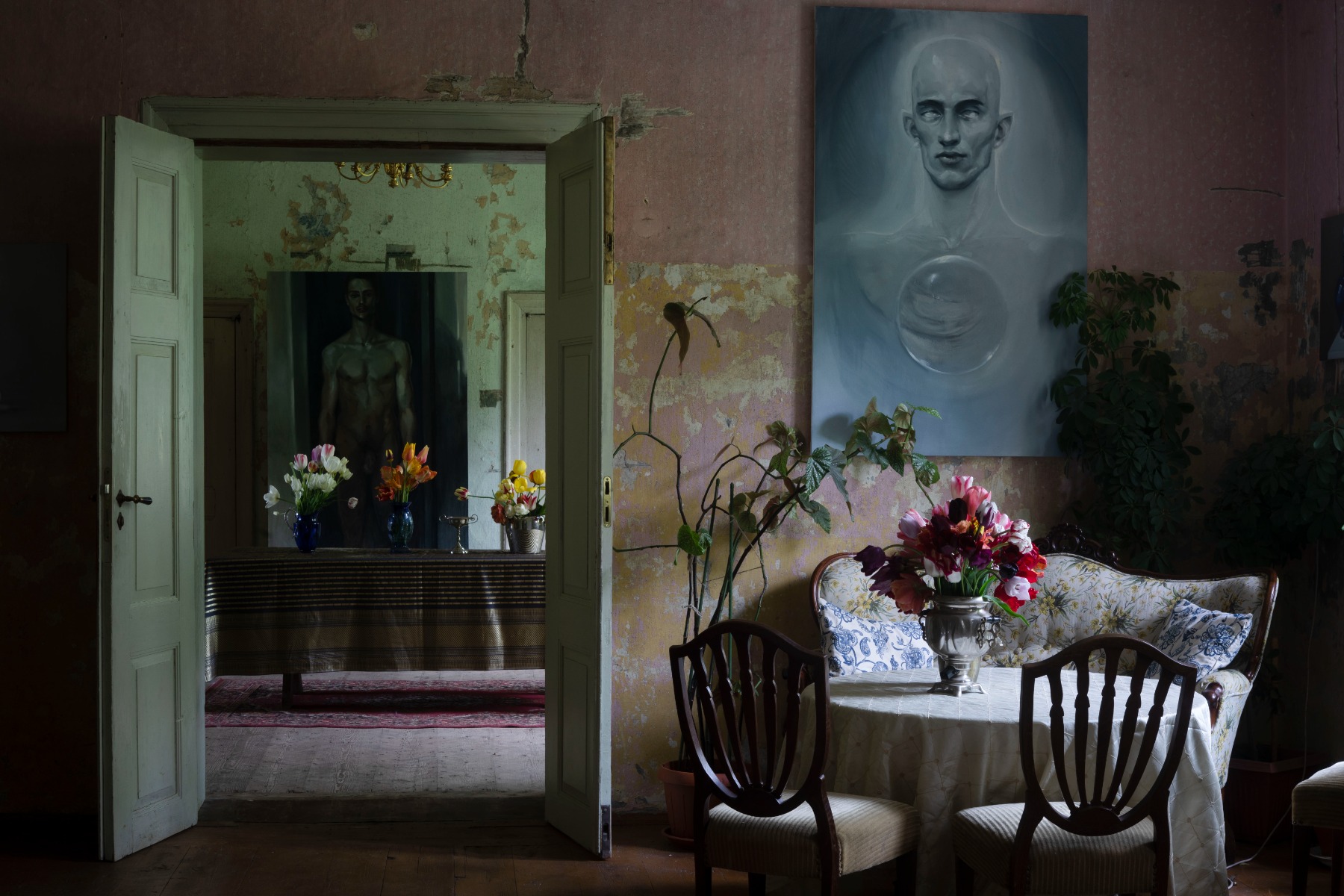
Did you manage to paint when you returned from India?
Yes. The series of paintings I did after India is very meditative. Being there allowed me to reach a much higher, more sensitive plane. I gradually abandoned trying to represent physical reality and started looking for that subtle and elusive dimension. This is how the series Frequencies (Euphoria) was born. I was interested in those states when you step out of the physical and into the transcendental. That fine line between sleep and wakefulness, the mundane and the divine, the subject and the object, the abandonment of identity, and the question of what lies beyond. But what is interesting is that perhaps at some point I began to linger there too much, and there was a desire to return to the physical, but now through a completely different way of seeing things – no longer tormented but interested.
Atis Jakobsons’ solo show. Exhibition view at the Padure Manor / until August 31
Basically, until India, you painted by letting go all the heaviness that had accumulated, and through this process you seemed to free yourself from the “rubbish” inside of you. But without really analysing what you were doing and why.
Perhaps it was some kind of collective trauma that I was dealing with in my work at the time. You’re washing laundry that is not even really yours.
At one time I practised Vipassanā meditation quite a lot, and one of the experiences was very special. I went underground and it was full of all kinds of creatures – a huge toad, a snake, demons... They were lying in a dank and rancid cave and nothing interested them. And I went there like an angel, with a candle of light in my hand as if I was bringing them a message from above – You, too, can be saved. You just have to want to go up.
I remember one of the paintings I did in Manchester had a Goyan influence – a skull, animals, birds, goblins, a huge tree, and a beam of light coming out of it. Accordingly, I titled the piece Sunshine. To indicate that this beam or density of light had been there. It doesn’t matter – in the end, it’s all one. Those goblins are simply stuck in their misery, and they may just stay there if someone doesn’t prod them. Consequently, it is important to see the divine in them as well and to remind them of it. Of course, until you really understand what you are doing, it is a difficult thing to do.
Another dream: I am in a vaulted cellar and three dark beings emerge from the depths of the earth, beckoning, Nobody loves you, nobody understands you, come with us. Classic. I think, hmmm...there’s something wrong here, I’m not going to let them hook me in. And the good witches are standing behind the glass door telling me, You have light tools, activate them. Suddenly, a whip of light appears in my hand, and I start to thrash the creatures.
This is the story of the light. In fact, I have been interested in angels since childhood. Aliens, angels and mysticism, those were my themes. I went down my own road much more when I was a kid. I was doing quite well, regardless of what people thought of me, and then all of a sudden, at some point, it dawns on you that you are being judged; you are being watched, and you feel ashamed that you feel something more, or that you are interested in topics that other people find strange. I remember you weren’t supposed to use the word "energy", for example, because then they’d laugh at you. Eventually, of course, you become jaded and adapt to your environment, and you start to doubt yourself.
I remember as a child I used to watch the clouds and imagine I was flying between them. The desire to be there was very acute. For a while, angels and clouds were what I wanted to paint. I felt an infinite freedom when I’d think about how I was flying between these cathedrals and mountains of clouds. Perhaps it was not just a child’s fantasy, but a memory of such a state.
Atis Jakobsons’ solo show. Exhibition view at the Padure Manor / until August 31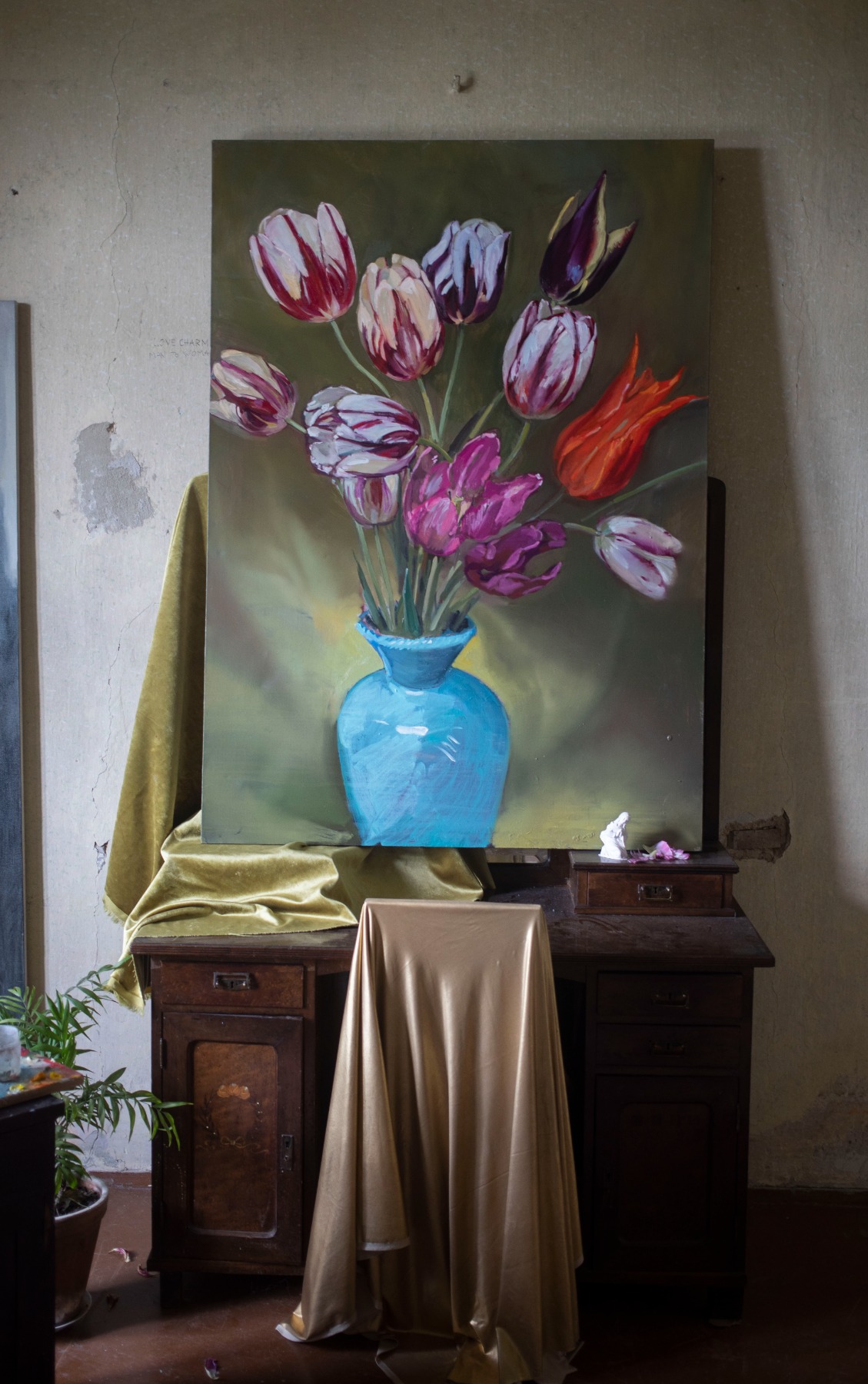
Precisely ten years have passed since this 2012 breaking point you mentioned. Have you spent them fully within the light?
We could create a mythos (laughs).
Regarding your current work, can you now say that it “is” you?
I’ve realised that life hands you only as much as you can bear. Even if it seems hard and difficult, those are millstones through which you have passed, and you actually pass through them quite easily. When I became more aware of sensory things, and I had found the space or field in which I could work, I naturally started to go deeper. Of course, it isn’t any easier down there. Like I said about the candle, when you go down into the basement where these beings are and you have this contact with the light, you can go very deep. And at the same time, there are two sides to it – I can go very deep or I can go very high. It’s something like a bridge.
Atis Jakobsons’ solo show. Exhibition view at the Padure Manor / until August 31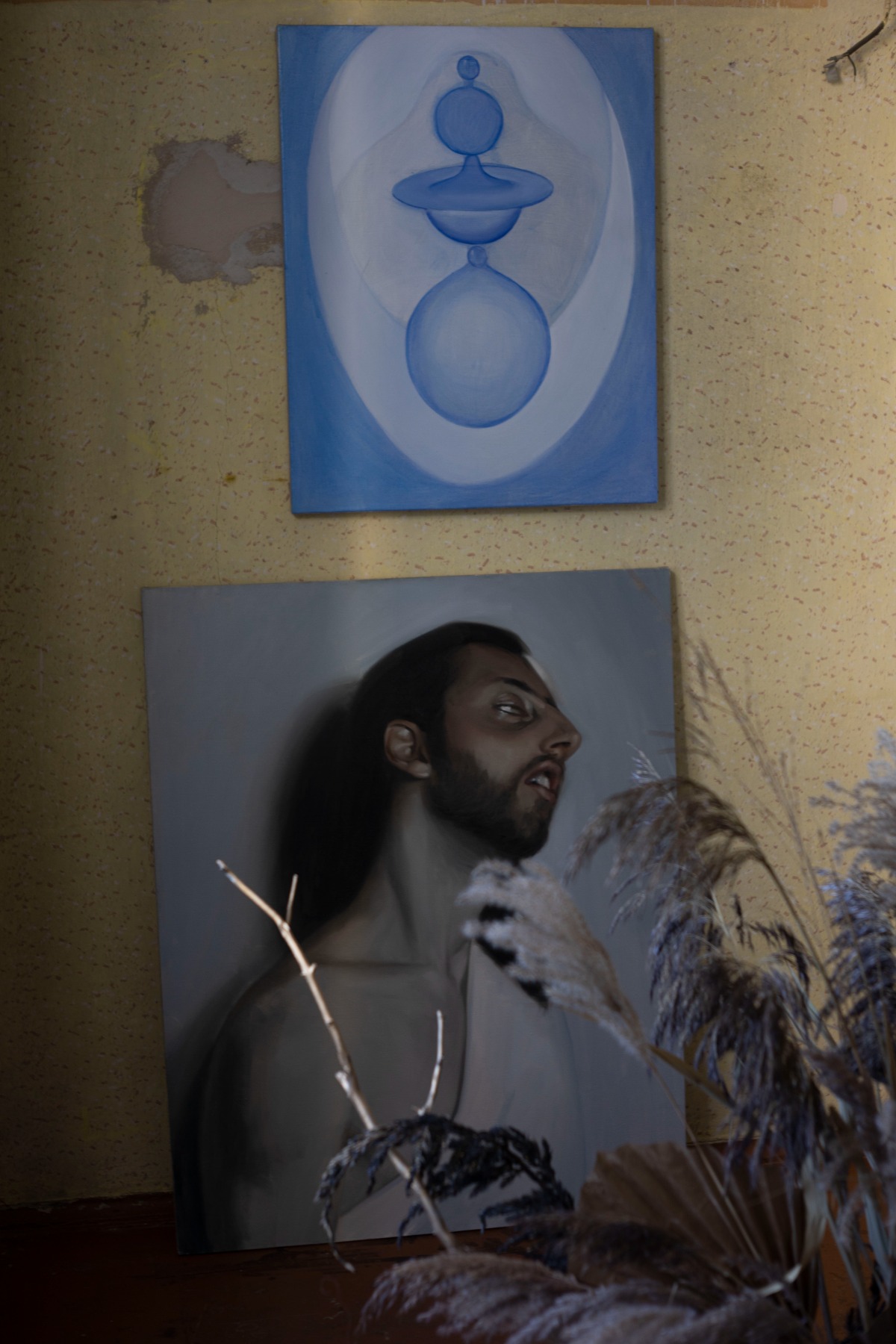
It is clear from the first part of our conversation that we are dealing with a person who feels energies, but doesn’t want to talk about it because people don’t understand. We are dealing with a person who receives visions, but does not talk about it because people do not understand. A person who first paints suffering, and then light. What is creating a work of art for you? Do you deal with your own issues and problems through art, or at some point do you also focus on collective issues in an attempt to help others?
That’s the eternal question: Who is the creator? It feels like something is flowing through me. I think it’s important to settle your relationship with yourself. There was a time when it was confusing to talk about one’s soul. Some say there is no soul, while others believe that there is. And until that is sorted out, I cannot say what it is that speaks through me. For example, if I deny the divine, how can it speak through me if I’m denying it?
Quite a long time has passed since I’ve begun trying to sort all this out within myself, and things are increasingly becoming clear. Lately I have also become aware of the seven bodies we have been given. There’s this physical, mental and also ethereal plane in which most of us reside. Then come the more subtle ones – the planes of the soul and energy. After India, I realised that they interest me more and more. Information that can be perceived through a more sensitive sense, not just what we can see or touch.
Of course, I also observe in a very human way what flows through me. I try to understand, to analyse, perhaps repeat it, and then I have the feeling that maybe today I want to draw something else, to invent something myself. And when I try to do that, it comes out clumsy, lame – it’s lacking that flow, that suppleness. When there is flow, it’s beautiful and uplifting.
When I was in the Himalayas for the first time and I had come down after a week of climbing, I had the urge to write. Of course, being in the mountains is very cleansing; the symbols were literally pouring out of me and then the sun shone in through the window and I sat and cried. That feeling of completeness and happiness. And I think – that’s not me, maybe it’s an aspect of my soul or a past life experience. But whenever I say that, I’m not claiming anything. I am here, and things could be one way, or they could be another way.
If I have not been able to draw, I often become irritable. It’s emotionally difficult for me, and when I start to create, it feels like it’s just flowing through me. It’s not easy to accept and acknowledge it rationally; there are people to whom I’ve shown these works who say, Watch out, you’ll lose your mind. I think I’m more likely to go mad if I don’t do it, because then I’m just blocking the channel shut.
Atis Jakobsons’ solo show. Exhibition view at the Padure Manor / until August 31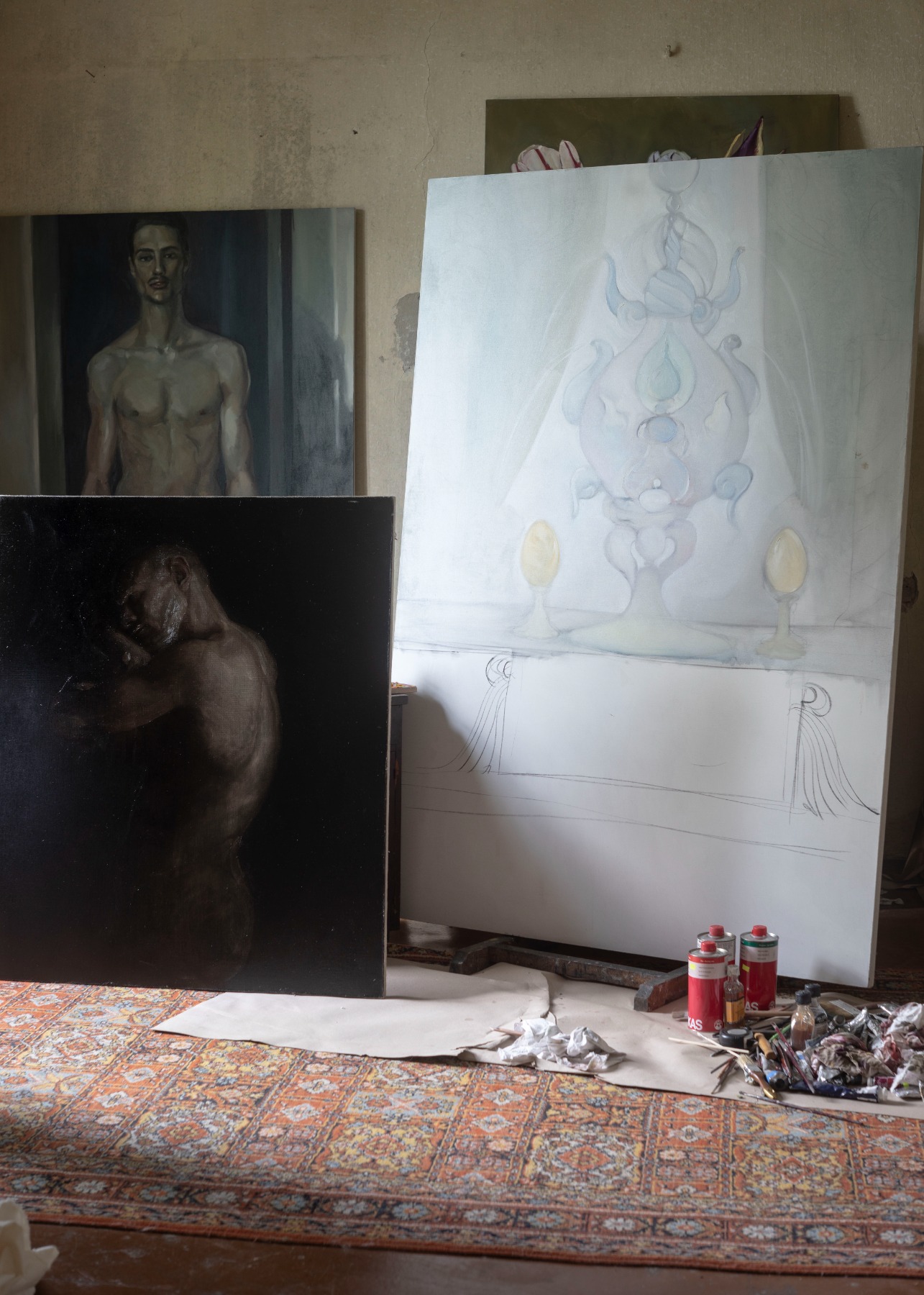
How would you even interpret what it means to lose your mind? Because by talking about what we are talking about right now, we are in a world of constructs of the mind. Souls don’t talk; they don’t communicate directly – it’s an exchange of energies.
I try very hard to avoid generalising and introducing categories. In 2020 I had an exhibition at Kim? called Grid – about how everything is a grid and everything is a construct in some way, and the collective experience of humanity is also contained in the grid. The question is, how inverted is this grid? If reality is said to be like this, it cannot be like this. And in the mind of those who live in this limiting box, whoever sticks his head out of that box is confused. It’s Plato’s Allegory of the Cave.
There have been experiences – through meditation, through ayahuasca – that the amount of information that comes in during these processes is simply too much for the limited perceptual apparatus of man. He feels that the system will break down because he wants to control everything. He wants to control what he thinks and feels. On top of that, he believes that there is no god and that he has created everything here. And if suddenly, during these experiences, a very powerful higher energy comes into him and just knocks all of this down and then proceeds to tell him that you are actually part of something that you cannot even comprehend, that could probably be called enlightenment. But most people – who are not ready for such experiences – are either afraid of this or consider it madness.
You’ve already included in your answer the paradox that humanity as a whole has lost its mind thousands of times during its evolution. If the mind does not understand that there is no one reality that is acceptable to all – because everyone lives in a reality of their own comprehension – then that is losing one’s mind.
I have been thinking about the saying that we each have our own cosmos. But I am increasingly beginning to understand that there is one cosmos. It’s like in a beehive – the humming is collective. Each bee does not think differently. I have felt that I would like everyone to dress the same and be able to focus on that subtle plane rather than endlessly expressing their individuality, which is actually living within an illusion. It’s a kind of paradox: we have the choice to do that – to raise our heads and try to understand, Why I am even here?, but we mostly busy ourselves with other things, e.g. Does anyone like me? What are they saying about me? How do I look? And the the wheel of Saṃsāra just goes round and round.
Returning to art – for me, personally, it is a return to inner peace. A return to that which is eternal, unchanging and always present. And I look for this through my works. To remind myself and maybe someone else. To get closer to that state of purified consciousness instead of constantly jumping from thought to thought and from feeling to feeling.
I used to be quite monochrome in my work, but in the last few years, colour has increasingly entered my work. I am becoming aware that everything has infinite connections. For example, the distribution of the colours of the rainbow, which corresponds to the chakra system and also to our system of musical notation. And then you realise that the number seven is everywhere – inside of us and also outside of us. In Christianity they speak of seven churches, and from a physiological-biological point of view, each chakra is responsible for one of the glandular centres in our body.
Colour for me is no longer just colour – it is a sound, a frequency. And it is scientifically measurable. I used to strictly avoid red because it was too strong for me, but now, when painting a red work, I am aware that I have immediately gone to working with a very specific chakra and energy. At some point you realise that this isn’t mysticism or esoterica – we all have these frequencies in us.
The book Eastern Body, Western Mind by Anodea Judith, which very nicely lays out that we have both the first three distinctly bodily chakras as well as the other four, greatly helped me in finding a balance within myself. And that energy has to circulate between them all the time. You are simultaneously in the physical body and in the divine plane. And then there is the heart, which connects these planes.
Atis Jakobsons’ solo show. Exhibition view at the Padure Manor / until August 31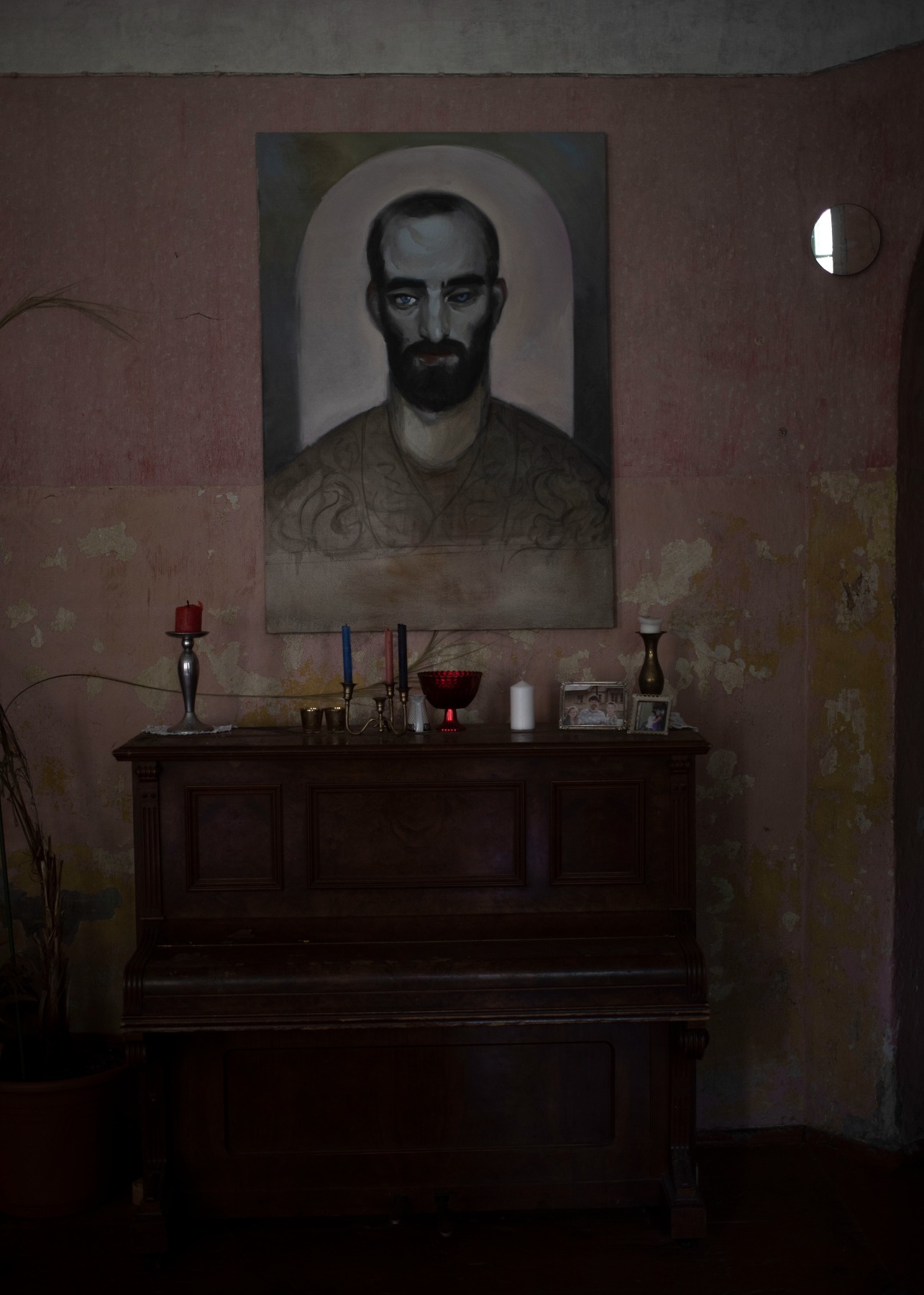
At the same time, like many others, you have long avoided talking about all this, aware of the risk of being labelled an esotericist. The stereotype is still so ingrained that even H&M sweatpants have phrases like Connect with your inner higher self on them.
I think that this is the place to invoke critical thinking. It is important to understand for yourself, because you can very quickly, so to speak, start following Osho and get into sectarianism. I have nothing bad to say about Osho; I have read him and he has interesting ideas, but there is also a lot of demagogy. The way he manipulates with words is phenomenal.
I really like the idea of complementarity. For something to be, it needs to have a negating aspect or an opposite. It is the principle of yin and yang; one is impossible without the other. I have realised that in the moments when I have doubts, or when a person says something and it knocks me off balance, it is not about that particular person. It is about my inner doubts, and he is simply mirroring them. And I need these mirrors because they help me to see where I still don’t trust myself or doubt myself.
I would certainly like to avoid polarisation – there are those who believe and those who don’t, or some may be stuck. The important thing is to understand that everyone will get where they need to go, and everyone will go at their own speed.
I have thought that if I could now meet myself in my twenties, and I started to talk about these things, my younger self would probably grab a drink and say to my older self, Sod off, I have a party to get to. I realise that this has been something one has had to go through, and I don’t see anything good or bad about it. They’ve all been crazy and cool experiences. I really don’t want to start grouping people into those who understand and those who don’t. There is a beautiful saying – everyone you will ever meet knows something that you don’t. And that’s where the wisdom is in everyone. There have been times when I see a completely random person walking down the street and I don’t like something about them, so I start to criticise them in my mind. But almost at the same moment, I start sending them a blessing. If there is something unsettled within me, perhaps they are mirroring what it is that I don’t like about myself, and as a defensive reaction, I imagine that this person is wrong, miserable, etc. From this point of view, sending a blessing is a wonderful practice. It helps to stop these negative thoughts and frees oneself from accumulating them. Sometimes, when I am in a good mood and I am on a train and I see people with dour faces, I send them a blessing in my mind. Because if I start reacting to the negativity, it comes into me, too.
There is one reality, but we each see it from our own point of view – as what we are – be it an animal, a snake, an owl, me, you, or as the critic who writes about your exhibition…
The field of the mind is very “delicious”. There are people with sharp and wonderful minds who can create very beautiful theories and play with them, but at the same time, what I see is the well-known parable of the dog trying to catch its own tail. I have realised that if there is no connection, no awareness of the divine or the superconscious, you can come up with anything. These are the mind tangles in which one can get lost and with which we can beautifully deceive each other – who is smarter, who is more contemporary, etc.
At the same time, there is that eternal struggle and attempts at trying to understand how things really are. One of the most popular questions posed to various gurus regards what to do with the ego. And then at some point, you realise that the ego, which is most probably also a construct of the mind, is something that you are working with. You are either best friends, or you are holding each other back in some way.
I would rather not use the word mind, but instead “a system of notions”. It’s important to sit with yourself and think – what do I believe? Why do I think it cannot be otherwise? The mind doesn’t end with something – as in, it woke up or it didn’t wake up, it achieved enlightenment or it didn’t achieve enlightenment – the mind just helps to operate within a particular software and puts the existing information together. At some point, I see, I feel, that I have to process new information that has come into me. I have to find a place for it. It is a kind of programming.
I’ve never gone bungee jumping, but it is fear that starts to put a spoke in the wheel – How are things going to turn out? In this case, the question is, Will I lose my mind? At that point, you have to come back to your breath. When I was practising Vipassanā, I realised that the only thing I can rely on – and the only thing which is even remotely real – is the breath. I breathe in, and I breathe out.
There is a theory that our brains are constantly making shortcuts because if they had to visualise what our eyes see all the time, they would simply crash. That’s how we know this is a tree, this is a house, this is good and this is bad – and we don’t think about it too much. Yet there is a meditation practice that consists of consciously looking at a tree. And you realise that it is not just a tree. Because what is a tree? It’s just a word that implies a certain system of notions. But when you look at it closer, you realise that it is a living being; it produces oxygen. You see the water that flows through its system; the tree is also a house. Let’s say, when you look at a house, you see the origin of the materials. The whole story is about unlocking these limiting blocks.
Atis Jakobsons’ solo show. Exhibition view at the Padure Manor / until August 31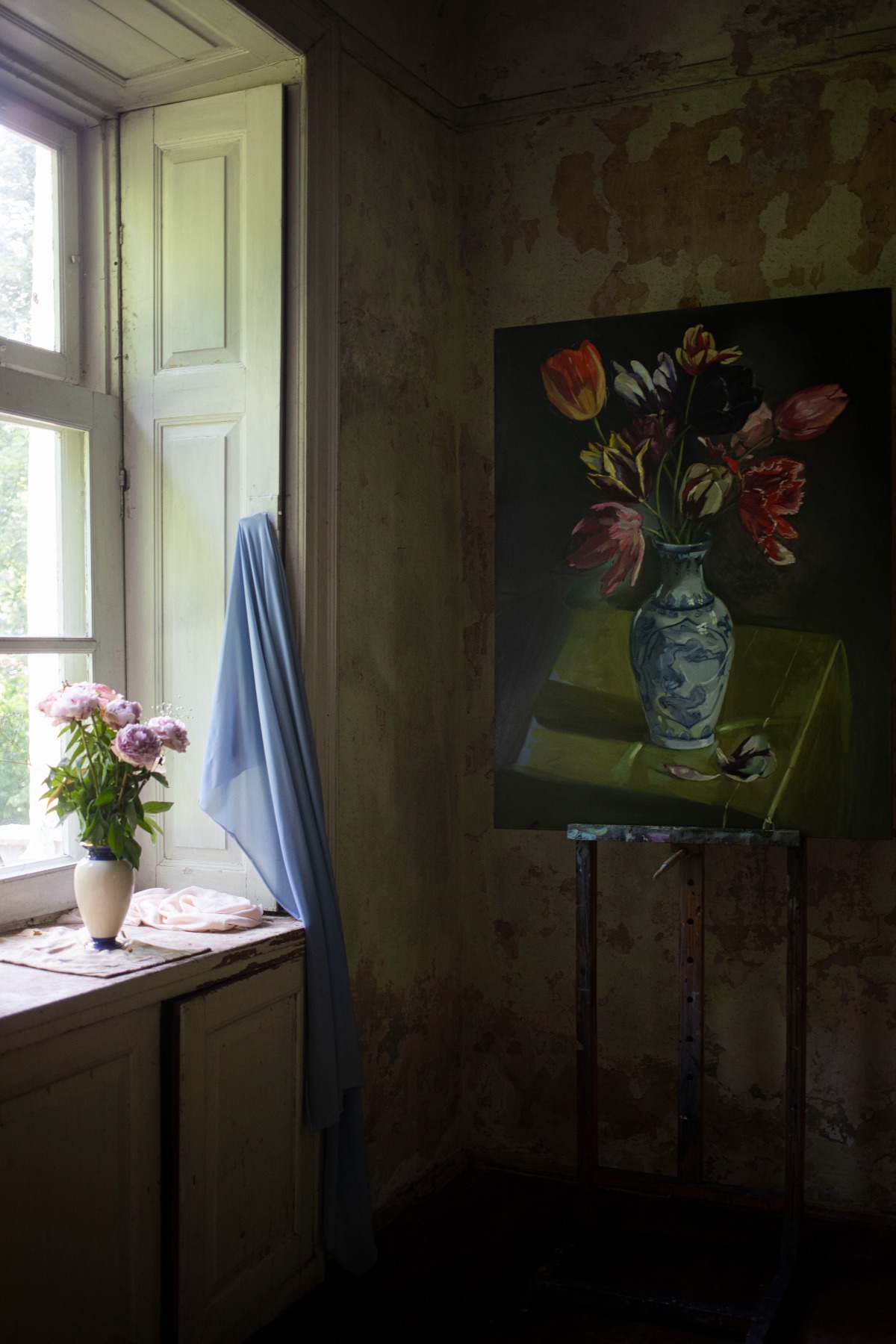
The works I create are also a liberation of myself from programs. And it’s becoming increasingly interesting. Right now, for example, I’m working with pastels, because pastels have this living, intuitive nature. It’s unpredictable in a way, and you’re also drawing with your fingers. So the contact is very direct, and I try to switch off my mind when I sketch – whatever comes into me, I let it flow. It feels like I’m translating a particular situation or the energy of the day through this relationship between colour, shape and space, and it’s very interesting for me to watch that process. It all starts with sketching out a shape, and then I very intuitively pick up shades and try to surprise myself. I also try to free myself as much as possible from the analytical mind, which can start saying things like, This isn’t working, What is that supposed to be?, etc. In this process of making, I discover something new all the time; in a sense, I see these works as emotional maps – maps made of colours, lines and spaces.
Whereas in the previous phase I had perhaps been working more with some sort of collective trauma, as well as with my own trauma, now there is this miracle of creation – an excitement and anticipation about what’s next. These relatively infinite possibilities. At the same time, it’s not just a childish joy – there’s also an element of healing. The pastels I work with have super-intense pigments – the kind that burn your eyes. For example, there’s a turquoise-blue shade, but you don’t really realise what you’re looking at – it’s no longer a colour, it’s a portal.
I think that intuitively, either consciously or unconsciously, I’m approaching art therapy. Healing through colour. Being in a field of colour really does heal you; colour is a pure frequency. Pure energy. I can also draw parallels here with my interest in flowers. I like to arrange flowers, and this year I started growing tulips. I have planted peonies in my parents’ garden. A flower is a pure form for me. It exhibits the stages of birth, growth and maturation, and the ultimate potential – pure colour – is reached. A form of meditation practice is meditating through or on flowers. You observe the flower until you become it in some way. Having painted a flower arrangement and having watched it for hours, I was overwhelmed by the feeling that I had arrived on some fantastic yellow planet with indescribably beautiful scents and happiness. This pure, uplifting and healing energy is what I want to convey to the viewer and to those who acquire these works. In this way, reminding them that we can actually feel a lot of happiness and joy at any moment. It is a cognizance of abundance.
Atis Jakobsons’ solo show. Exhibition view at the Padure Manor / until August 31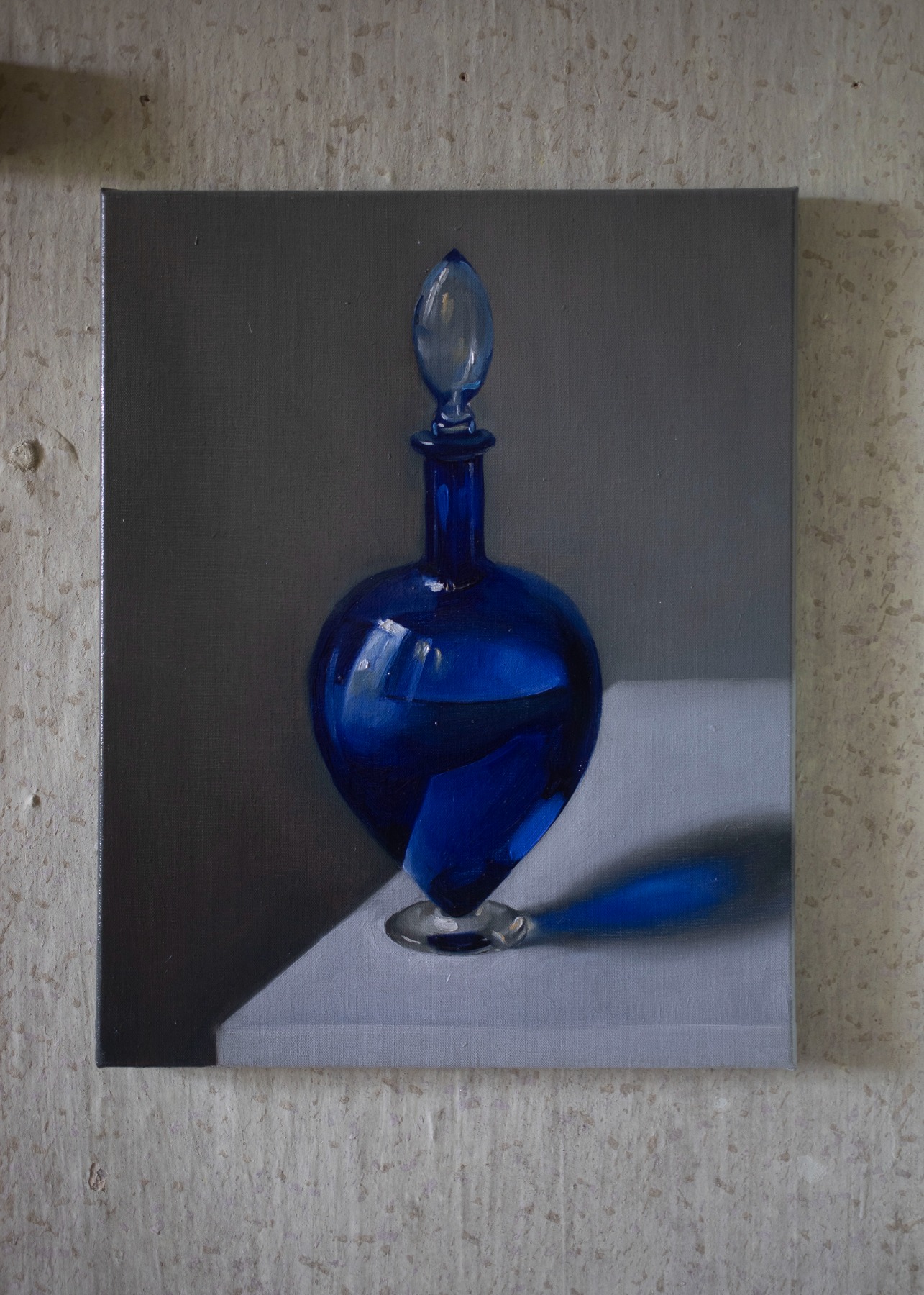
I have come to realise in meditation that if there is this tapping into such a cosmic flow of love, it cannot be used up – it is limitless. We live in a time where people believe in the idea that there is “mine” and there is “yours”, and that there is enough for only one. But, for example, everybody can access the energy of the sun, and it’s the same with these works – I want to activate this flow of love and light. If we look at what’s going on in the world right now, yes, things are harsh, and maybe for some people that’s the only reality right now, and that’s all the more reason why I want to show this space outside of all that…
Sometimes when I’m arranging flowers, I get so carried away by these compositions that I can get lost in them for days and weeks. I see in the fragility of flowers an analogy with human lives. A flower blooms and is only here for a few days; a person – for a few decades. I want to record each flower, and when I put together the compositions according to the colours, it could be a life story that is being told. Some have darker shades, some are lighter – it’s up to you. Maybe what I’m trying to say is to see the beautiful in everything and everyone, and to be able to appreciate it. (...) Of course, I can’t say whether or not there is a cosmic plan – there probably is – but I don’t need to know that.
I read the other day that we are a planet of free will and that we always have a choice. I find that very interesting.
Atis Jakobsons’ solo show. Exhibition view at the Padure Manor / until August 31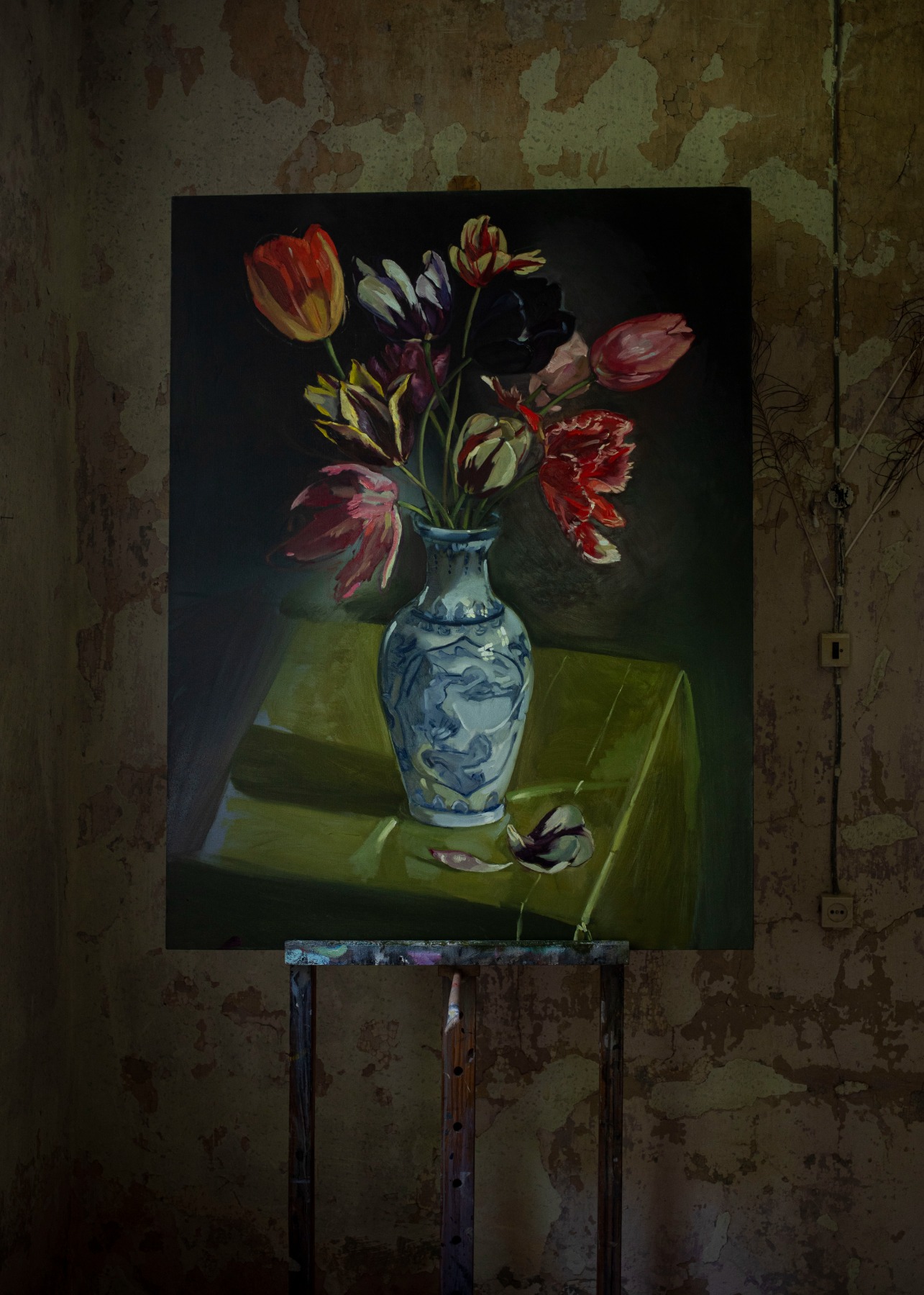
When it comes to flowers, what they teach us is that everything physical has a beginning and an end. Only the nature of the cycle changes – a flower has one kind, a butterfly – another; a mosquito has its own kind, while a human, a tree, and an elephant have yet others. We will all die – that is known at birth. But we try to push it aside and obscure it with an increasing amount of ephemera, because the question of meaning makes us uncomfortable. Do you agree that everything only makes sense when you see that the essence is in the bloom itself?
I will answer with a quote from a dream. Perhaps through watching flowers, I got too caught up in the finality of a flower having a beginning and an end. And then the dream seemed to remind me that there is spring, and there is autumn. This cycle is infinite; climb out of finality and focus on what is infinite.
I think that sometimes it is important to understand or to touch what is eternal. When that happens, your perspective changes completely. There are times when I manage to capture that state, while at other times, life just comes at you and I fall through it – I capsize the boat and get wet. At the same time, there are moments that could be called “the eye of the needle” – I am at peace and I have the feeling that reality is flowing through me. There is no yesterday or tomorrow, just a continuous present. And just like in a film, I suddenly realise that I can change it. I am actually observing something that I am creating with my mind because I have given it meaning. These states are so pleasant and inspiring, and it’s worth being in them more often.
Abstracting from esoteric theories, there is a cut-off point – physical life, which has a beginning and an end. The question is, what can I do in it? In some sense, I am fascinated by this existence of death; and being aware of the temporality of the physical plane, I realise that I want to paint more. Of course, I could sit and do nothing, but the consciousness of the fact that I am leaving something behind is ever present. I want to create these miracles because, in a way, every work is a miracle for me. The more I let go, the more fantastic the experience of creation is. It’s similar to what I’ve experienced in meditation, in ceremonies, and in sleep. I have this desire to show them off, to give them to someone. I’ve had people stand in front of one of my works and say, This is what I saw in my dream. This encounter or connection has happened.
Atis Jakobsons’ solo show. Exhibition view at the Padure Manor / until August 31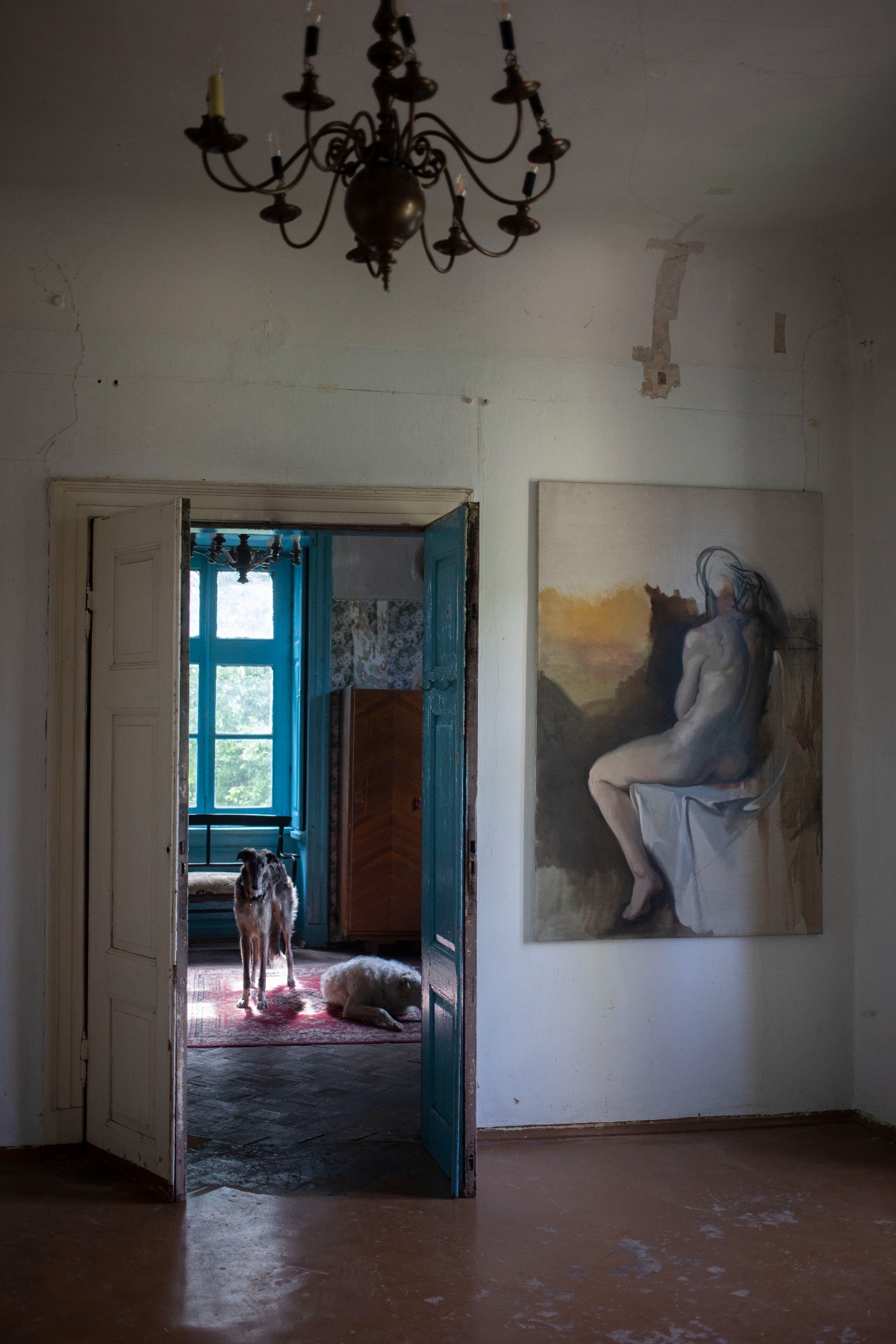
You mentioned the yellow planet that you “go to” when you look at the flowers, and how you put it on canvas or paper to allow the viewer to go to that place as well. You’ve mentioned collecting these drawings in a book that could then serve as a meditation tool.
During one of my meditations, I was overcome by the feeling that consciousness, even on the highest planes of existence, is very colourful and resonant. And if I were to sit here as a pure form, there would simply be an explosion of colour. I feel within myself a singing, dancing and colourful being of light that wishes to communicate – through colour, through symbols, and that comes through in the work.
In one of my dreams, I’m flying in an outer space of colours and sounds. There is no physical body; I am this coloured ocean, and it is a fantastic feeling. That doesn’t mean that it’s bad here; we learn and experience a lot through the physical, but at the same time, there is this need to shine, to let the soul heal.
I think this book could be a kind of bridge that reminds people of their infinite cosmic, colourful and fantastic selves. I feel that there is a need for it because the way these works are made is a gift to oneself as well as a gift to others. In every sense, I am in a very elated mood after making them. I have allowed these codes to come through me – colour combinations and shapes that are completely new to me as well – and I have this inner belief that they are not just images. Someone else who looks at them might also experience a similar journey of colours and shapes. I want to put all these works together to encourage people to see that every day, every moment, can be so very different. And then the meditation happens naturally. If one allows oneself to be captivated by what is depicted there, and switches off the analytical mind, I believe that this set of images can also be a kind of manual for self-discovery. A map of the soul to the labyrinth of the subconscious.
What is creation? Have you ever thought about that? In a sense, we are all creators; if it were not for this act of creation, we would not exist.
Creation is birth. It is what the soul wants to do – to create and know itself in its infinite diversity.
At the same time, I have always found this program aspect interesting. They have been launched at some point, and they continue to function like a virus. For example, the notion that I can’t do something. For instance, someone has said that you can’t sing, and so you don’t sing. These programs are so hard-wired that they are difficult to break. I suppose if a person really met their potential, they might be scared of it because they’re not ready for it.
Am I allowed to be happy? There will always be reasons – for example, how can I smile if that person or that country is going through a difficult time? You have to suffer, too, otherwise it is a kind of betrayal. These are anchors that are probably necessary. Humans are not yet ready to fly.
Probably the most important thing is to be able to take the time to see it, to think about it, and then start working on it. In my case, I can draw it. I can draw the aspect of me that is afraid of a happy life and talk to it – what are we giving each other? What is this deal for mutual benefit?
Atis Jakobsons’ solo show. Exhibition view at the Padure Manor / until August 31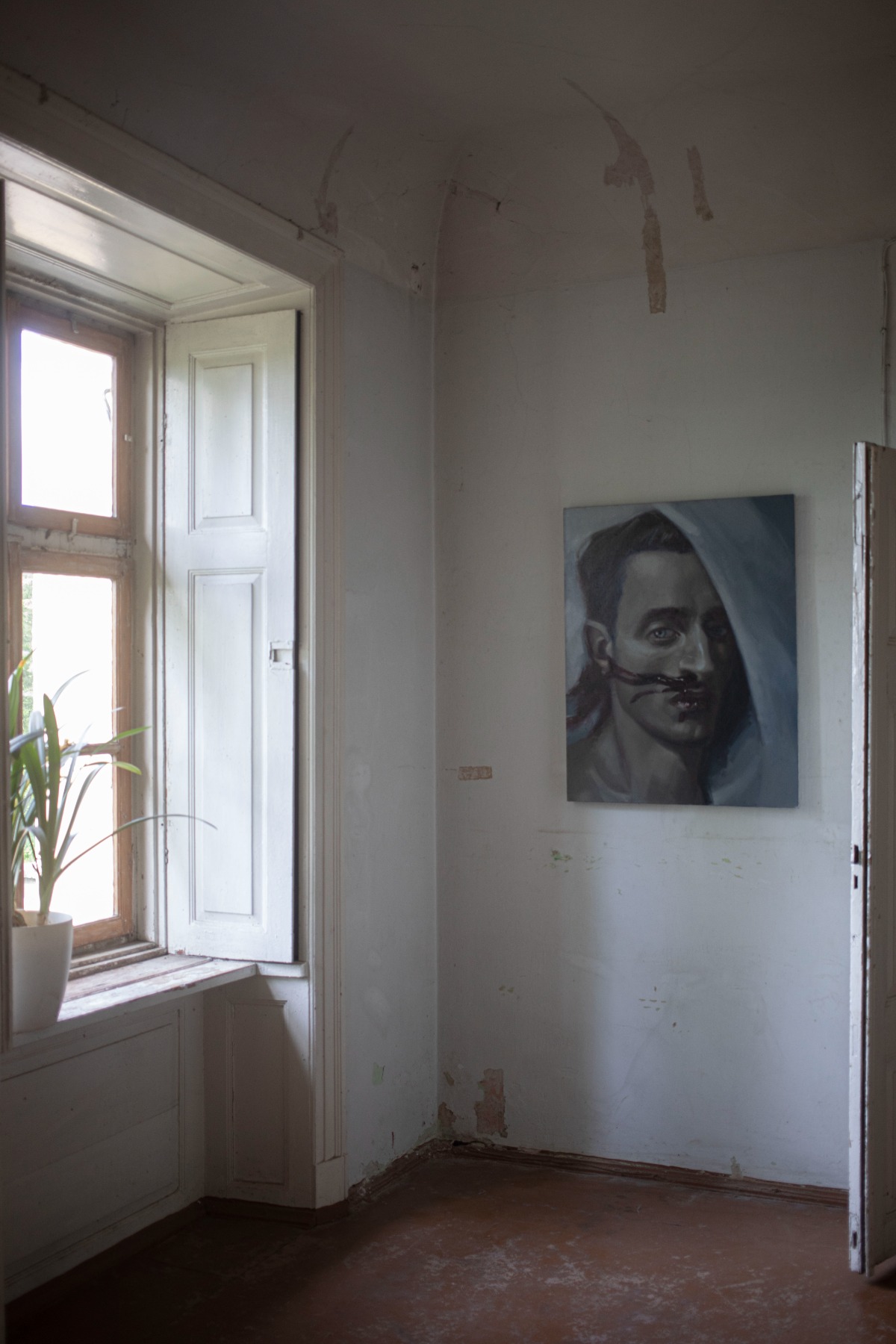
Is there anything you can’t do as an artist?
I don’t really have a doubt about my ability; it’s more a question of wanting to do it – who needs this? It’s important for me to feel that what I do is necessary and that I can’t do without it. I am also interested to some extent in video, especially digital animation, but I don’t have experience in that and I would have to learn. I’ve been thinking that a lot of what happens inside me – dreams, meditations – also happens in time. There is some sort of movement, progress and transformation in it. I put a sort of concentrated essence of what is happening into the image, but perhaps nothing more is needed at the moment. I already spend so much time on the astral planes that I feel I need the physical material – pastels or oil paint – because it is through that that this manifestation on the physical plane takes place. Video or music – that’s something much more ethereal and intangible. Whereas a painting is like being carved in stone. To draw the line.
I’ve noticed that when working with computer programs, Photoshop and 3D modelling programs, there’s this feeling that you can create anything. You have these tools and you can create worlds, spheres, but as soon as I have to draw it by hand, I find that I can’t even draw a circle anymore because the computer has basically started doing it for me. I have a theory that what we can physically draw by ourselves also indicates how far an idea is from reality. This is something I want to perfect – to draw the perfect form as I see it. It comes out askew, and this crookedness contains the human element – through my inability, I realise that I have room to grow. It reminds me that I am still very imperfect as a human being, and in that sense, I like to come back to this.
After a Vipassanā meditation I once went to Florence, walked around the museums and came across Raphael’s Madonna and Child. I stood and looked, realising that when he created this work, he was already in an enlightened state because it is no longer just the physical plane but something much higher – this absolute perfection and harmony. Then I came upon the Baroque works, which I found very sexual; it was hard to see the spirituality in it. Caravaggio seemed too down-to-earth, although I have always liked him. Erotic street scenes with half-naked people, going too far into the physical; pleasure dominates all thought and idea. The 19th century, for its part, seemed like the Netflix of its time – large-format battle scenes where the emphasis is on the story and its illustration. Raphael’s Madonna contained a kind of cosmic ideal; he seemed to have succeeded in depicting an angelic perfection of form and thought, a divine plan, something that could not be embodied on earth. On the basis of this artistic achievement, as the centuries go on, one feels that humans have become increasingly lost. The 20th century, for example, seemed like a history of humanity’s mental illness. I didn’t even get to the 21st century.
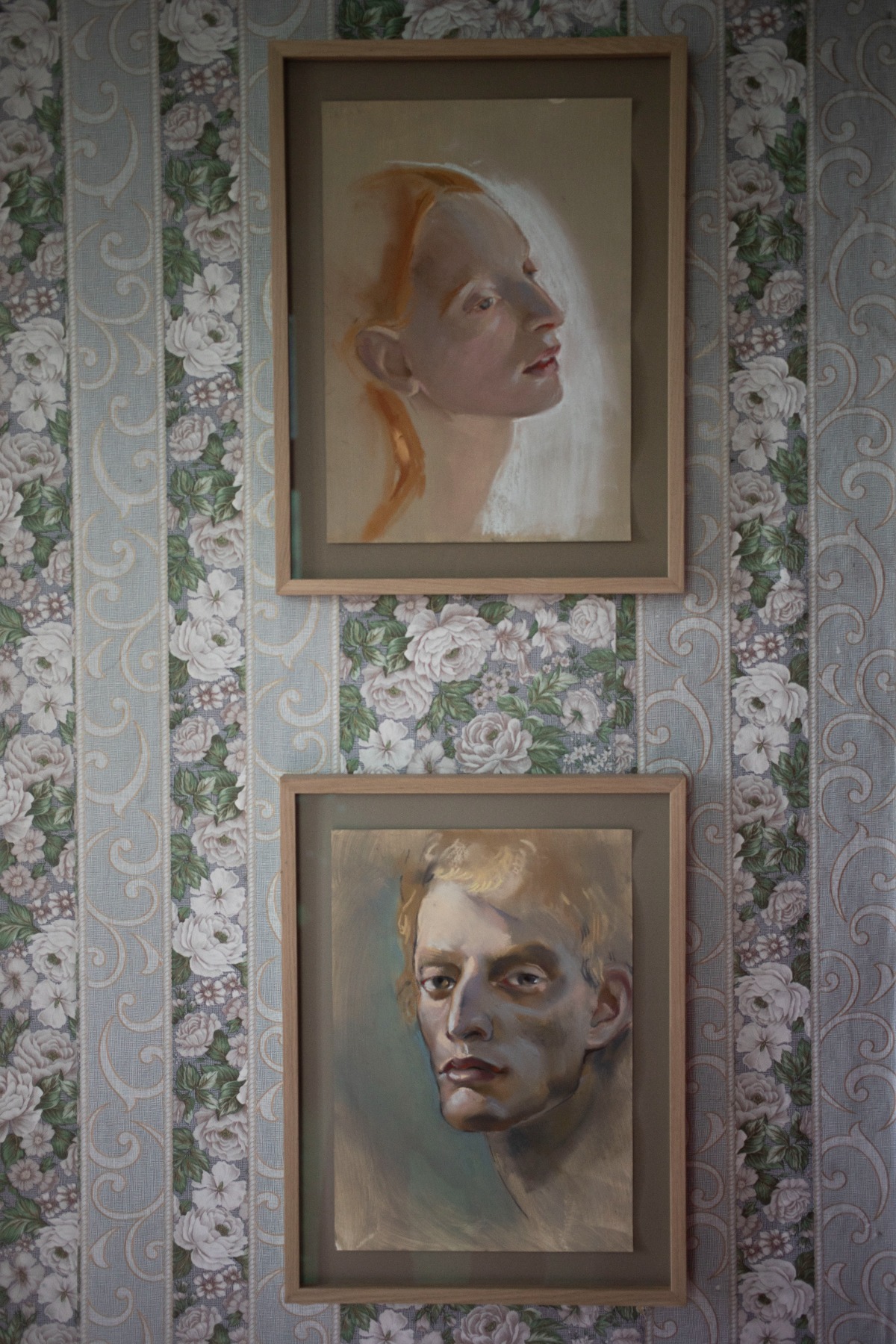
Perhaps the 21st century is the one in which we are approaching transcendence. Everything has been and nothing new can be invented, so there’s a certain need to end it all and start again. This does not mean the end of the world, of course, just another paradigm shift.
With your exhibition at Padure Manor you are also, in a way, closing a phase in yourself.
When I moved to Berlin in 2012 after having returned from India, I was already trying to understand the nature of suffering through a more conscious perspective. The inner depths of the subconscious, so to say. I started to do more portraiture, and sometimes I even directly asked them to connect to what each of them was afraid of or what was hurting them in their lives. I think there was also a healing aspect – both for the person whose portrait was being done and for me.
There was a desire in me to touch the person, their essence. I don’t want to call suffering their “essence”, because suffering is not the only thing that makes up a person. I was interested in the person behind the mask that we all wear every day. These were very intimate and deep sessions, a kind of meditation, and in this way I collected what could be called an archive of emotional portraits.
At that time I also put forward the theory of the urban monk. A person who is dedicated to an inner search of oneself but without wanting to follow a particular model, denomination or religion. These people are among us – they may even go to parties – but you can literally feel the wisdom radiating from them. There is perhaps a cosmic sadness in their eyes, something that could be called an old soul, even though they are sometimes very young in years.
The portraits on display at Padure Manor were painted between 2018 and 2022. Some were painted during the pandemic. This moment of suffering may be echoed somewhere, but the story is more about overcoming it. Through my own experience, I have realised that if, for example, something hurts in the body, you don’t have to immediately pop some ibuprofen but you should instead go inside the pain. It is a very transformative experience. I am not against ibuprofen, but if I have a toothache, I don’t take it and instead try to release aspects of myself through the pain. This transformation path is visible at Padure.
There’s also a series of still lifes there – mostly glass vessels with water. I became interested in them when I was painting flowers; when I took them out, there was just a bowl of water left, which, in a sense, is a symbol of purification. It’s like you’re painting something that’s not there – the transparent water that you can’t really see, but at the same time it refracts the light very beautifully, concentrates it in itself, and so the shadow also becomes lighter. It has the energy of light. This movement, from darkness to light.
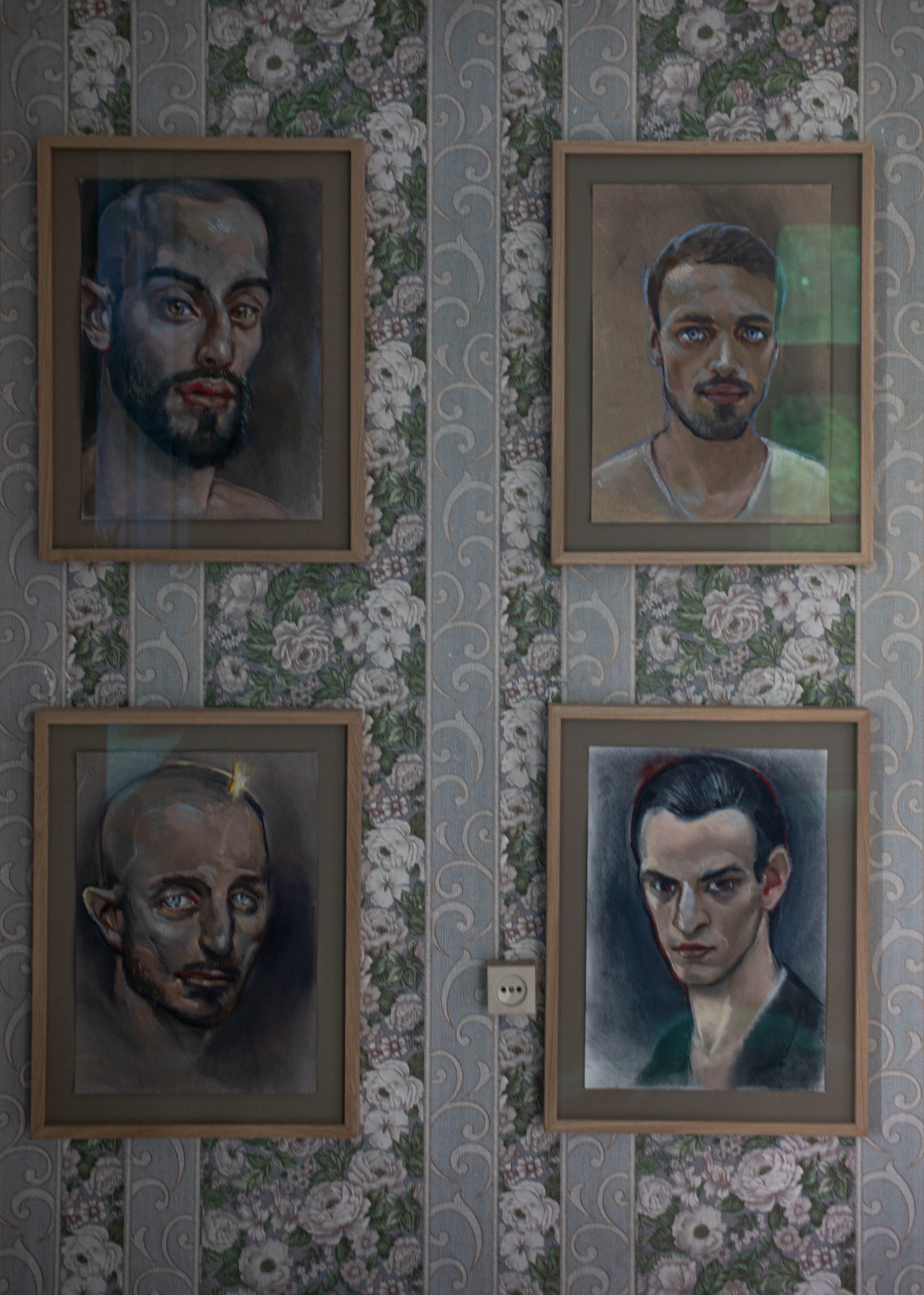
In Marina Abramović’s legendary Manifesto for an Artist’s Life, she speaks about the artist’s relationship with silence: “An artist has to understand silence; An artist has to create a space for silence to enter his work”. Perhaps that is also the artist’s task at this moment – to create the opportunity for a transformative transition? For those who are ready for it, who are ready to see a little more.
Last year I had an exhibition in the Karosta water tower of the former Liepāja Fortress. Some of these works are also on show at Padure Manor. At first I thought I would paint portraits in the tower, but I couldn’t touch that. I was on the top floor of the tower and there were windows on all sides, but you couldn’t see through them because the windows were made of glass blocks. It was as if you were sitting in a capsule of light. I wrote a lot while there, and I also felt a bit like a monk in a monastery, in some unidentifiable century. Then I started going to antique shops in Liepāja, collecting and buying all kinds of fabrics, glassware, religious objects and figurines. It was more about creating an atmosphere. In the tower I worked with light, and fabric is one of the materials that can materialise it. I remember painting a large still life, the sun going around the tower and the shadows disappearing with it. I painted all day and I didn’t understand where to put the shadows – so I have a work without shadows; it’s very light. And then there’s the history of the tower, of the whole harbour; I was hanging fabrics, rearranging figurines, and the whole time I felt as if I was arranging something. The air had a real charge to it. There were other people who felt it as well.
Working with fabric is one thing I want to continue doing. I love the lightness of it; the wind comes into the room and the fabric reacts to it. Its fluctuations are intangible but, at the same time, you can feel them.
The other thing is the smell; when I was working in the tower, the peonies were blooming. They were literally radiating the energy of love. I was there for about a month, and what was obviously happening was that the artist (or the urban monk that I mentioned) was transforming the space. He had created a mood – through works, light and images. It’s a format that is increasingly catching my interest. Just being in a space, without any dogmas or rules.
I have the desire to create my own space – a studio, a temple – an environment in which I stay and change the exhibition; it could also be ongoing throughout the year. It is no longer tied to a particular art institution, but becomes a kind of sanctuary. You can go there and live for a bit or just meditate. Cultivate and multiply the energy that I myself enjoy being in. Perhaps what is happening in me at the moment is a kind of formulating of ideas or a testing of possibilities – in a sense, also a saying goodbye to the old.
If at the beginning of our conversation we spoke about these heavy energies, right now I feel that they have been lived through and are done. It has been a powerful, enriching and also difficult experience, and now I have started to paint over these works. It’s a kind of desire to cleanse myself. The question I ask myself is whether I should continue to carry this energy with me, because in a sense, as an artist, I do.
At one point I had the urge to take these works off their frames, roll them up in a big roll, and bury them in the ground. Let the magnetism and energy of the earth neutralise what I have dealt with and also immortalised within those works. It’s also an interesting inner dialogue about where the artist is as an ego, and where is the creator, the creative being. The artist’s ego says, How can you bury your works in the ground? They have to be sold or given to a museum. Whereas in terms of feelings, they seem to be just evidence of the past. I don’t want that anymore right now because as long as these works are in the same room with me, I am, in a sense, feeding them energy. And I think, That’s enough now! This process is very interesting, but I also don’t want to destroy the works because then the balance will be upset. I think that burying them is an anchor of sorts, because you can’t just have happiness and joy – the balance aspect is very important.
Atis Jakobsons’ solo show. Exhibition view at the Padure Manor / until August 31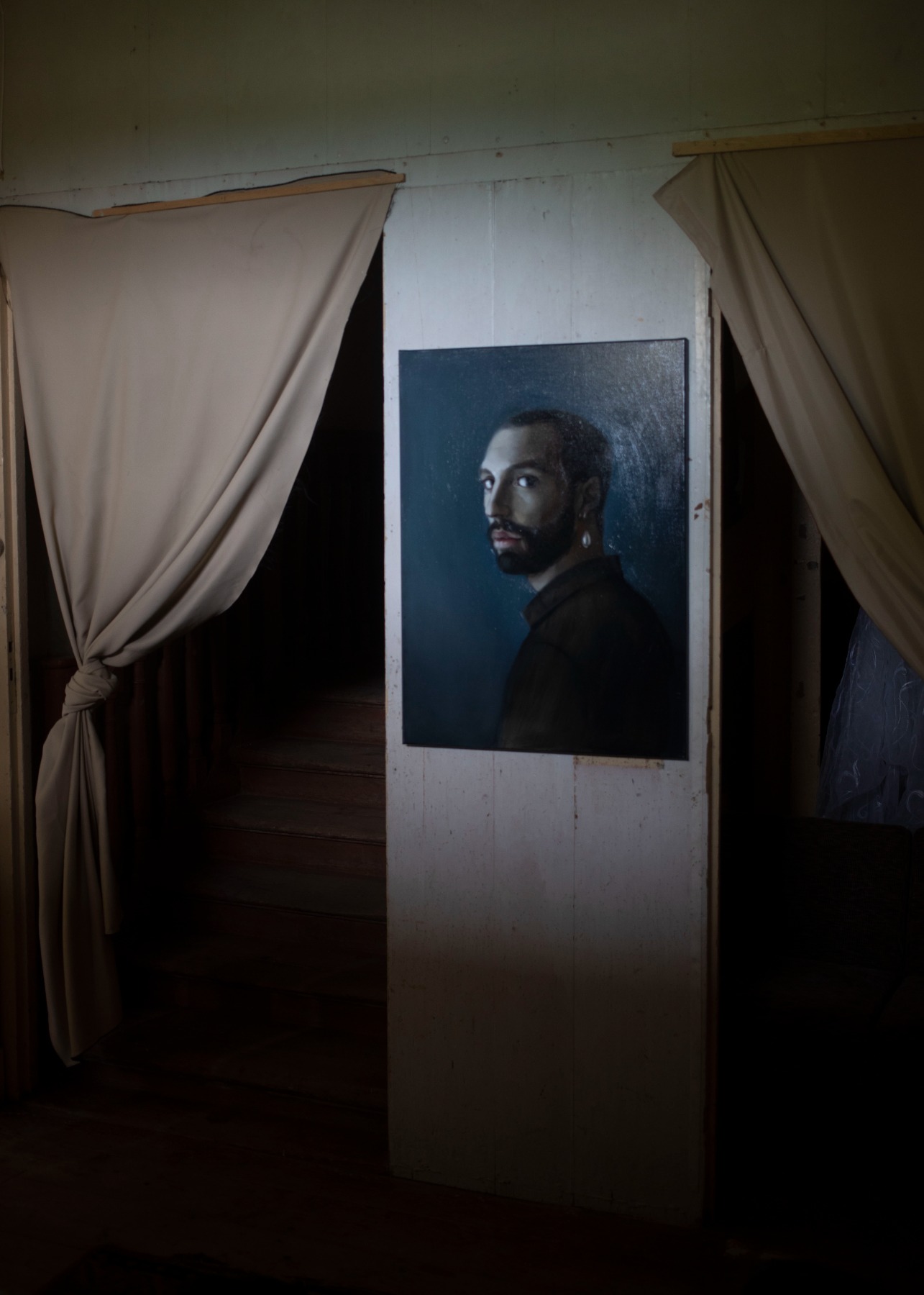
Maybe that is also what we should do with ourselves – bury the old and let something new be born.
It’s a very difficult transition, but at the same time, it is very simple. There are habits that we very much want to keep; as well as the point of view of what will others think about me. But I think that the Covid era has very much neutralised and diminished all that. Everybody is busy with their own fears and problems, and people don’t have much time to idly talk about other people’s lives. This is a time when people are really being given the opportunity to open up and get to know themselves. To stay and be with oneself.
Atis Jakobsons’ solo show. Exhibition view at the Padure Manor / until August 31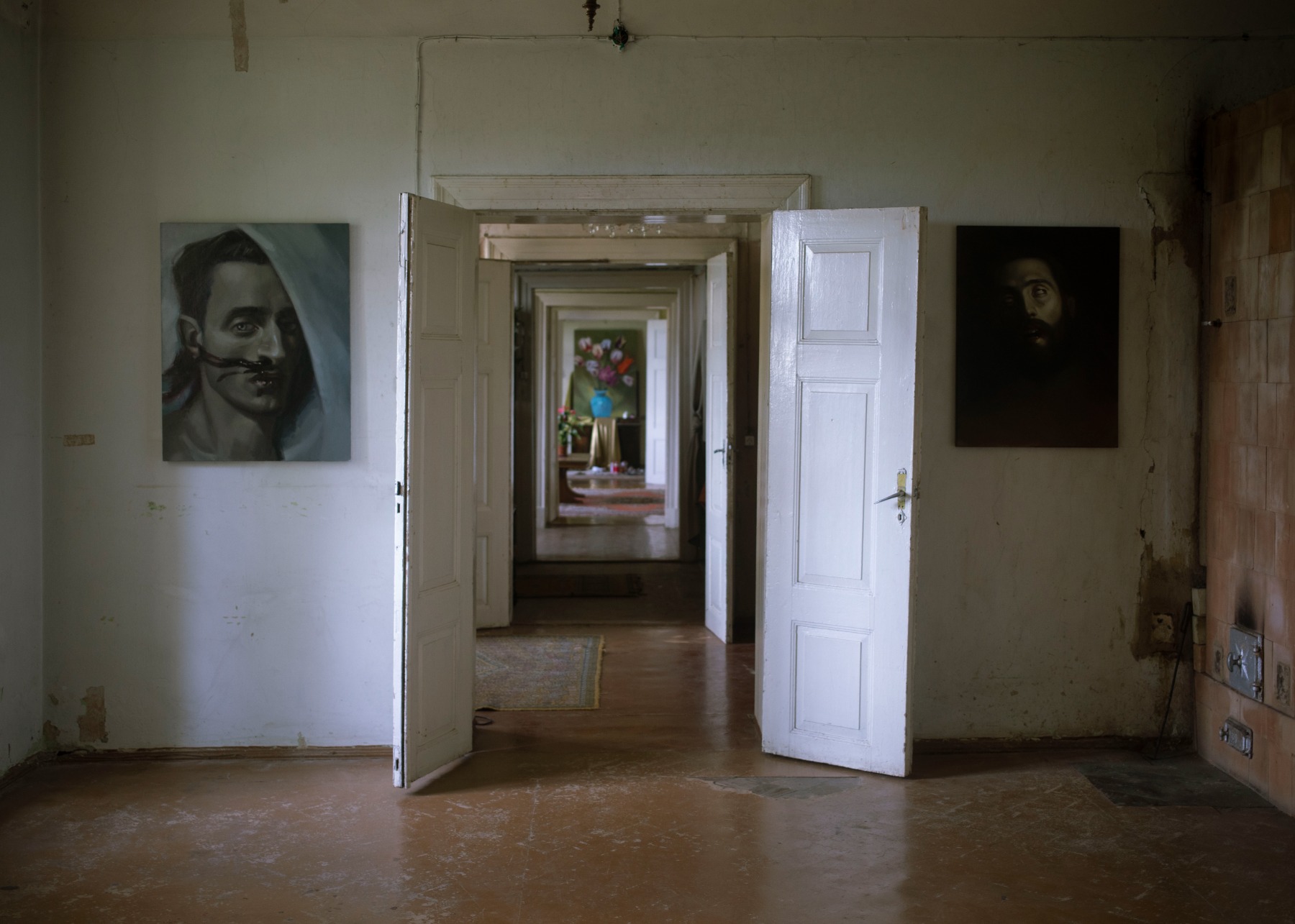
Atis Jakobsons’ solo show is on view at Padure Manor until August 31.
Title image: Atis Jakobsons and Rafael. Photo: Līga Bondare